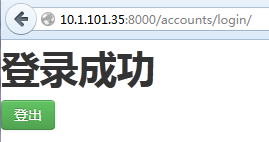django版本:1.4.21。
一、准备工作
1、新建项目和app
|
1
2
3
4
5
|
[root@yl-web-test srv]# django-admin.py startproject lxysite[root@yl-web-test srv]# cd lxysite/[root@yl-web-test lxysite]# python manage.py startapp accounts[root@yl-web-test lxysite]# lsaccounts lxysite manage.py |
2、配置app
在项目settings.py中的
|
1
2
3
4
5
6
7
8
9
10
11
12
13
|
installed_apps = ( 'django.contrib.auth', 'django.contrib.contenttypes', 'django.contrib.sessions', 'django.contrib.sites', 'django.contrib.messages', 'django.contrib.staticfiles', # uncomment the next line to enable the admin: # 'django.contrib.admin', # uncomment the next line to enable admin documentation: # 'django.contrib.admindocs', 'accounts',) |
3、配置url
在项目urls.py中配置
|
1
2
3
4
5
6
7
8
9
10
11
12
|
urlpatterns = patterns('', # examples: # url(r'^$', 'lxysite.views.home', name='home'), # url(r'^lxysite/', include('lxysite.foo.urls')), # uncomment the admin/doc line below to enable admin documentation: # url(r'^admin/doc/', include('django.contrib.admindocs.urls')), # uncomment the next line to enable the admin: # url(r'^admin/', include(admin.site.urls)), url(r'^accounts/', include('accounts.urls')),) |
4、配置templates
新建templates目录来存放模板,
|
1
2
3
|
[root@yl-web-test lxysite]# mkdir templates[root@yl-web-test lxysite]# lsaccounts lxysite manage.py templates |
然后在settings中配置
|
1
2
3
4
5
6
|
template_dirs = ( # put strings here, like "/home/html/django_templates" or "c:/www/django/templates". # always use forward slashes, even on windows. # don't forget to use absolute paths, not relative paths. '/srv/lxysite/templates',) |
5、配置数据库
我用的是mysql数据库,先创建数据库lxysite
|
1
2
|
mysql> create database lxysite;query ok, 1 row affected (0.00 sec) |
然后在settings.py中配置
|
1
2
3
4
5
6
7
8
9
10
|
databases = { 'default': { 'engine': 'django.db.backends.mysql', # add 'postgresql_psycopg2', 'mysql', 'sqlite3' or 'oracle'. 'name': 'lxysite', # or path to database file if using sqlite3. 'user': 'root', # not used with sqlite3. 'password': 'password', # not used with sqlite3. 'host': '10.1.101.35', # set to empty string for localhost. not used with sqlite3. 'port': '3306', # set to empty string for default. not used with sqlite3. } } |
然后同步数据库:同步过程创建了一个管理员账号:liuxiaoyan,password,后面就用这个账号登录和注销登录。
|
1
2
3
4
5
6
7
8
9
10
11
12
13
14
15
16
17
18
19
20
21
22
|
[root@yl-web-test lxysite]# python manage.py syncdbcreating tables ...creating table auth_permissioncreating table auth_group_permissionscreating table auth_groupcreating table auth_user_user_permissionscreating table auth_user_groupscreating table auth_usercreating table django_content_typecreating table django_sessioncreating table django_siteyou just installed django's auth system, which means you don't have any superusers defined.would you like to create one now? (yes/no): yesusername (leave blank to use 'root'): liuxiaoyane-mail address: liuxiaoyan@test.compassword: password (again): superuser created successfully.installing custom sql ...installing indexes ...installed 0 object(s) from 0 fixture(s) |
至此,准备工作完成。
二、实现登录功能
使用django自带的用户认证,实现用户登录和注销。
1、定义一个用户登录表单(forms.py)
因为用的了bootstrap框架,执行命令#pip install django-bootstrap-toolkit安装。
并在settings.py文件中配置
|
1
2
3
4
5
6
7
8
9
10
11
12
13
14
|
installed_apps = ( 'django.contrib.auth', 'django.contrib.contenttypes', 'django.contrib.sessions', 'django.contrib.sites', 'django.contrib.messages', 'django.contrib.staticfiles', # uncomment the next line to enable the admin: # 'django.contrib.admin', # uncomment the next line to enable admin documentation: # 'django.contrib.admindocs', 'bootstrap_toolkit', 'accounts',) |
forms.py没有强制规定,建议放在和app的views.py同一目录。
|
1
2
3
4
5
6
7
8
9
10
11
12
13
14
15
16
17
18
19
20
21
22
23
24
25
26
27
28
29
30
31
32
33
|
#coding=utf-8from django import formsfrom django.contrib.auth.models import userfrom bootstrap_toolkit.widgets import bootstrapdateinput,bootstraptextinput,bootstrapuneditableinputclass loginform(forms.form): username = forms.charfield( required = true, label=u"用户名", error_messages={'required':'请输入用户名'}, widget=forms.textinput( attrs={ 'placeholder':u"用户名", } ) ) password = forms.charfield( required=true, label=u"密码", error_messages={'required':u'请输入密码'}, widget=forms.passwordinput( attrs={ 'placeholder':u"密码", } ), ) def clean(self): if not self.is_valid(): raise forms.validationerror(u"用户名和密码为必填项") else: cleaned_data = super(loginform,self).clean() |
定义的登录表单有两个域username和password,这两个域都为必填项。
2、定义登录视图views.py
在视图里实例化上一步定义的用户登录表单
|
1
2
3
4
5
6
7
8
9
10
11
12
13
14
15
16
17
18
19
20
21
22
23
24
25
26
27
28
29
30
31
32
33
34
|
# create your views here.from django.shortcuts import render_to_response,render,get_object_or_404 from django.http import httpresponse, httpresponseredirect from django.contrib.auth.models import user from django.contrib import authfrom django.contrib import messagesfrom django.template.context import requestcontext from django.forms.formsets import formset_factoryfrom django.core.paginator import paginator, pagenotaninteger, emptypagefrom bootstrap_toolkit.widgets import bootstrapuneditableinputfrom django.contrib.auth.decorators import login_requiredfrom forms import loginformdef login(request): if request.method == 'get': form = loginform() return render_to_response('login.html',requestcontext(request,{'form':form,})) else: form = loginform(request.post) if form.is_valid(): username = request.post.get('username','') password = request.post.get('password','') user = auth.authenticate(username=username,password=password) if user is not none and user.is_active: auth.login(request,user) return render_to_response('index.html',requestcontext(request)) else: return render_to_response('login.html',requestcontext(request,{'form':form,'password_is_wrong':true})) else: return render_to_response('login.html',requestcontext(request,{'form':form,})) |
该视图实例化了前面定义的loginform,它的主要业务流逻辑是:
1、判断必填项用户名和密码是否为空,如果为空,提示“用户名和密码为必填项”的错误信息。
2、判断用户名和密码是否正确,如果错误,提示“用户名或密码错误”的错误信息。
3、登录成功后,进入主页(index.html)
3、登录页面模板(login.html)
|
1
2
3
4
5
6
7
8
9
10
11
12
13
14
15
16
17
18
19
20
21
22
23
24
25
26
27
28
29
30
31
32
33
34
35
36
37
38
39
40
41
42
43
44
45
46
47
48
|
<!doctype html>{% load bootstrap_toolkit %}{% load url from future %}<html lang="en"><head> <meta charset="utf-8"> <title>数据库脚本发布系统</title> <meta name="description" content=""> <meta name="author" content="朱显杰"> {% bootstrap_stylesheet_tag %} {% bootstrap_stylesheet_tag "responsive" %} <style type="text/css"> body { padding-top: 60px; } </style> <!--[if lt ie 9]> <script src="//html5shim.googlecode.com/svn/trunk/html5.js"></script> <![endif]--> <!-- <script src="//ajax.googleapis.com/ajax/libs/jquery/1.9.0/jquery.min.js"></script>--> {% bootstrap_javascript_tag %} {% block extra_head %}{% endblock %}</head><body> {% if password_is_wrong %} <div class="alert alert-error"> <button type="button" class="close" data-dismiss="alert">×</button> <h4>错误!</h4>用户名或密码错误 </div> {% endif %} <div class="well"> <h1>数据库脚本发布系统</h1> <p>?</p> <form class="form-horizontal" action="" method="post"> {% csrf_token %} {{ form|as_bootstrap:"horizontal" }} <p class="form-actions"> <input type="submit" value="登录" class="btn btn-primary"> <a href="/contactme/"><input type="button" value="忘记密码" class="btn btn-danger"></a> <a href="/contactme/"><input type="button" value="新员工?" class="btn btn-success"></a> </p> </form> </div></body></html> |
配置accounts的urls.py
|
1
2
3
4
5
6
7
|
from django.conf.urls import *from accounts.views import login,logout urlpatterns = patterns('', url(r'login/$',login), ) |
4、首页(index.html)
代码如下:
|
1
2
3
4
5
6
7
8
9
10
11
|
<!doctype html>{% load bootstrap_toolkit %}<html lang="en">{% bootstrap_stylesheet_tag %}{% bootstrap_stylesheet_tag "responsive" %}<h1>登录成功</h1><a href="/accounts/logout/"><input type="button" value="登出" class="btn btn-success"></a></html> |
配置登出的url
|
1
2
3
4
5
6
7
8
|
from django.conf.urls import *from accounts.views import login,logout urlpatterns = patterns('', url(r'login/$',login), url(r'logout/$',logout), ) |
登录视图如下:调用djagno自带用户认证系统的logout,然后返回登录界面。
|
1
2
3
4
|
@login_requireddef logout(request): auth.logout(request) return httpresponseredirect("/accounts/login/") |
上面@login_required标示只有登录用户才能调用该视图,否则自动重定向到登录页面。
三、登录注销演示
1、执行python manage.py runserver 0.0.0.0:8000
在浏览器输入ip+端口访问,出现登录界面

2、当用户名或密码为空时,提示“用户名和密码为必填项”

3、当用户名或密码错误时,提示“用户名或密码错误”

4、输入正确用户名和密码(创建数据库时生成的liuxiaoyan,password),进入主页

5、点击登出,注销登录,返回登录页面。
四、排错
1、'bootstrap_toolkit' is not a valid tag library
因为你的installed_app没有安装'bootstrap_toolkit',安装即可。
资源链接
http://www.zzvips.com/article/148197.html
http://www.zzvips.com/article/148190.html
以上就是本文的全部内容,希望对大家的学习有所帮助,也希望大家多多支持服务器之家。
原文链接:https://www.cnblogs.com/starof/p/4724381.html










